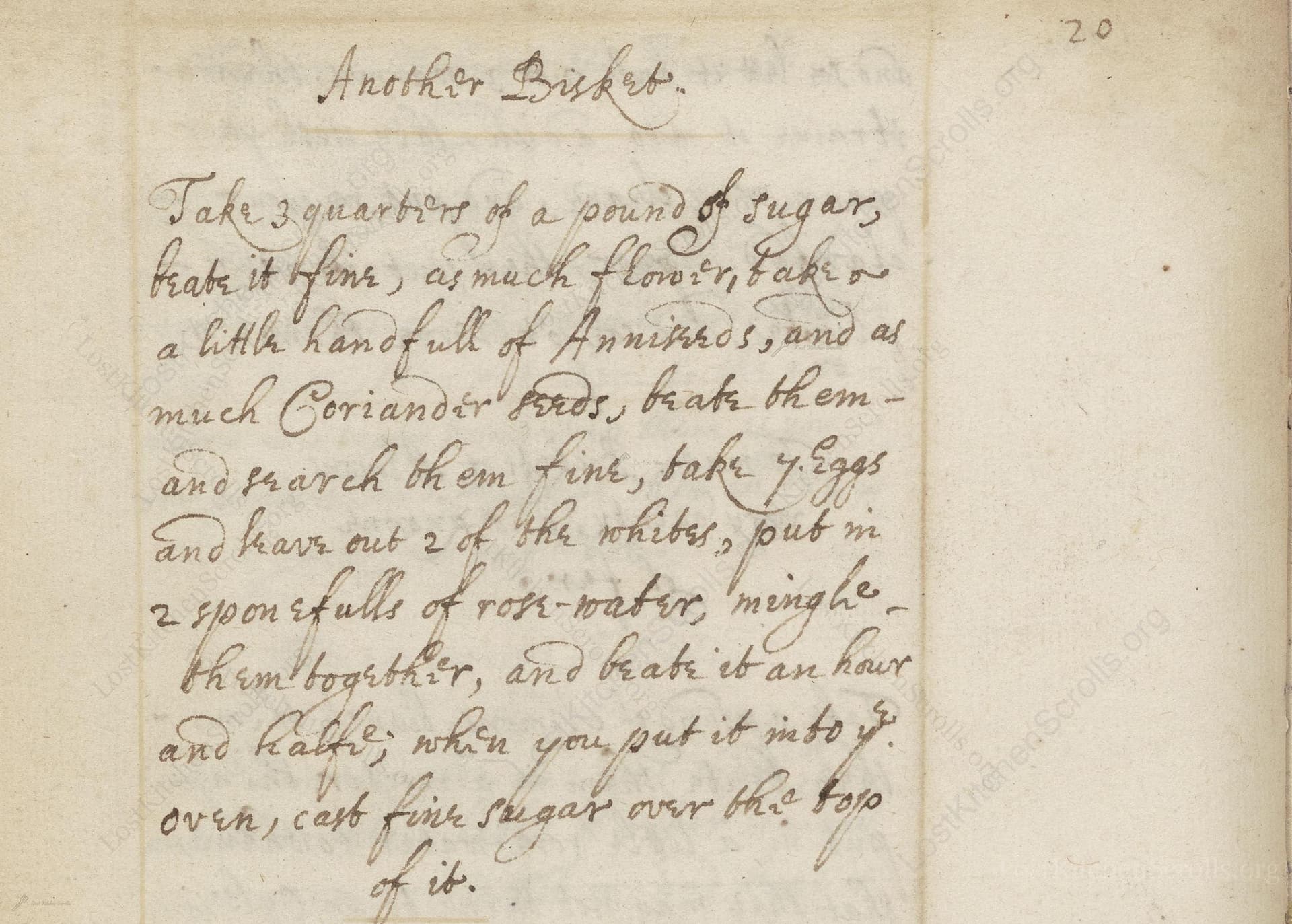Another Bisket
From the treasured pages of Receipt book of Sarah Longe
Written by Sarah Longe

Another Bisket
"Take 3 quarbers of a pound of sugar, beate it fine, as much flowr, take on a little handfull of Anniseeds, and as much Coriander seeds, beate them fine, take 4 Eggs and have out 2 of the whites, put in 2 spoonfulls of rose-water, mingle them togather, and beate it an hour and halfe; when you put it into ye oven, cast fine sugar over the topp of it."
Note on the Original Text
Like many recipes of its era, this one eschews precise measurements in favor of 'handfuls' and 'quarbers,' reflecting a hands-on approach and the assumption of kitchen experience. Spelling is idiosyncratic ('flowr' for flour, 'beate' for beat) and punctuation is sparse. The recipe omits baking times and temperatures, presuming the cook's familiarity with their hearth, and expects vigorous manual labor—'beate it an hour and halfe.' Modern readers benefit from recalibrated measures, standardized spelling, and the luxury of electric mixers to realize this herbal, floral treat.

Title
Receipt book of Sarah Longe (1610)
You can also click the book image above to peruse the original tome
Writer
Sarah Longe
Era
1610
Publisher
Unknown
Background
A delightful glimpse into early 17th-century kitchens, this collection by Sarah Longe whisks readers through ancestral recipes, cooking tips, and the seasonings that graced the tables of Jacobean England. Prepare to savor the tastes and traditions of times gone by.
Kindly made available by
Folger Shakespeare Library
This recipe, penned around 1610 by Sarah Longe, hails from the flourishing English tradition of spiced 'bisket' (biscuit) or rusk-like treats served as a sweetmeat at banquets and after feasts. 'Biskets' were a fashionable nibble among the Elizabethan and Jacobean elite, often sweetened and aromatically spiced with Old World ingredients and imports like aniseed and rose water. Such recipes reflect the era's palate for delicate, perfumed confections and the influence of continental baking on English kitchens. The survival of Longe’s recipe offers a rare, delicious glimpse into early modern domestic cookery and the role of women in preserving culinary traditions.

In the 17th century, this recipe would have called for a mortar and pestle to finely grind spices, a wooden or ceramic mixing bowl, and hand-held whisks or bundles of twigs for arduous beating—hence the impressive hour and a half for proper aeration. The oven would have been a wood-fired hearth or brick oven, and parchment or leaves might have lined the baking trays. Sprinkling sugar on top would have been done by hand, drawing from precious sugar cones.
Prep Time
1 hr 50 mins
Cook Time
30 mins
Servings
16
We've done our best to adapt this historical recipe for modern kitchens, but some details may still need refinement. We warmly welcome feedback from fellow cooks and culinary historians — your insights support the entire community!
Ingredients
- 12 oz granulated sugar
- 12 oz plain flour (wheat)
- 2 tsp (0.18 oz) aniseeds, ground
- 2 tsp (0.18 oz) coriander seeds, ground
- 4 eggs (use only 2 egg whites, all yolks)
- 1 fl oz (2 tbsp) rose water
- Extra granulated sugar for sprinkling
Instructions
- To prepare these delicate early 17th-century 'biskets,' begin by weighing out 12 ounces of granulated sugar and 12 ounces of plain wheat flour.
- Grind together 2 teaspoons (about 0.18 ounces) each of aniseeds and coriander seeds in a spice grinder or mortar and pestle until fine, incorporating both their unique perfumes into the mixture.
- Crack 4 eggs, but set aside and discard 2 of the whites, leaving you with 4 yolks and 2 whites.
- Beat the eggs together with 2 tablespoons (1 fluid ounce) of rose water until frothy and well combined.
- In a large bowl, mingle all ingredients, then beat the batter vigorously by hand or stand mixer for 1.5 hours—a feat of endurance in 1610, but straightforward today!
- Pour the batter into a parchment-lined baking tray, sprinkle over an extra spoonful or two of fine sugar, and bake at 320°F (160°C) for about 25–30 minutes until golden on top—watch for a lightly risen, delicate crumb.
Estimated Calories
170 per serving
Cooking Estimates
You will spend about 20 minutes preparing your ingredients, about 1.5 hours mixing the batter, and then 30 minutes baking. Each biscuit contains about 170 calories if you cut the tray into 16 pieces.
As noted above, we have made our best effort to translate and adapt this historical recipe for modern kitchens, taking into account ingredients nowadays, cooking techniques, measurements, and so on. However, historical recipes often contain assumptions that require interpretation.
We'd love for anyone to help improve these adaptations. Community contributions are highly welcome. If you have suggestions, corrections, or cooking tips based on your experience with this recipe, please share them below.
Join the Discussion
Rate This Recipe
Dietary Preference
Main Ingredients
Culinary Technique

Den Bockfisch In Einer Fleisch Suppen Zu Kochen
This recipe hails from a German manuscript cookbook compiled in 1696, a time whe...

Die Grieß Nudlen Zumachen
This recipe comes from a rather mysterious manuscript cookbook, penned anonymous...

Ein Boudain
This recipe comes from an anonymous German-language manuscript cookbook from 169...

Ein Gesaltzen Citroni
This recipe, dating from 1696, comes from an extensive anonymous German cookbook...
Browse our complete collection of time-honored recipes



